Your cart is empty
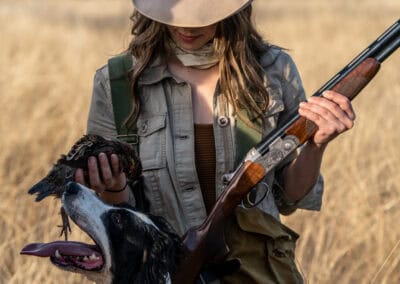
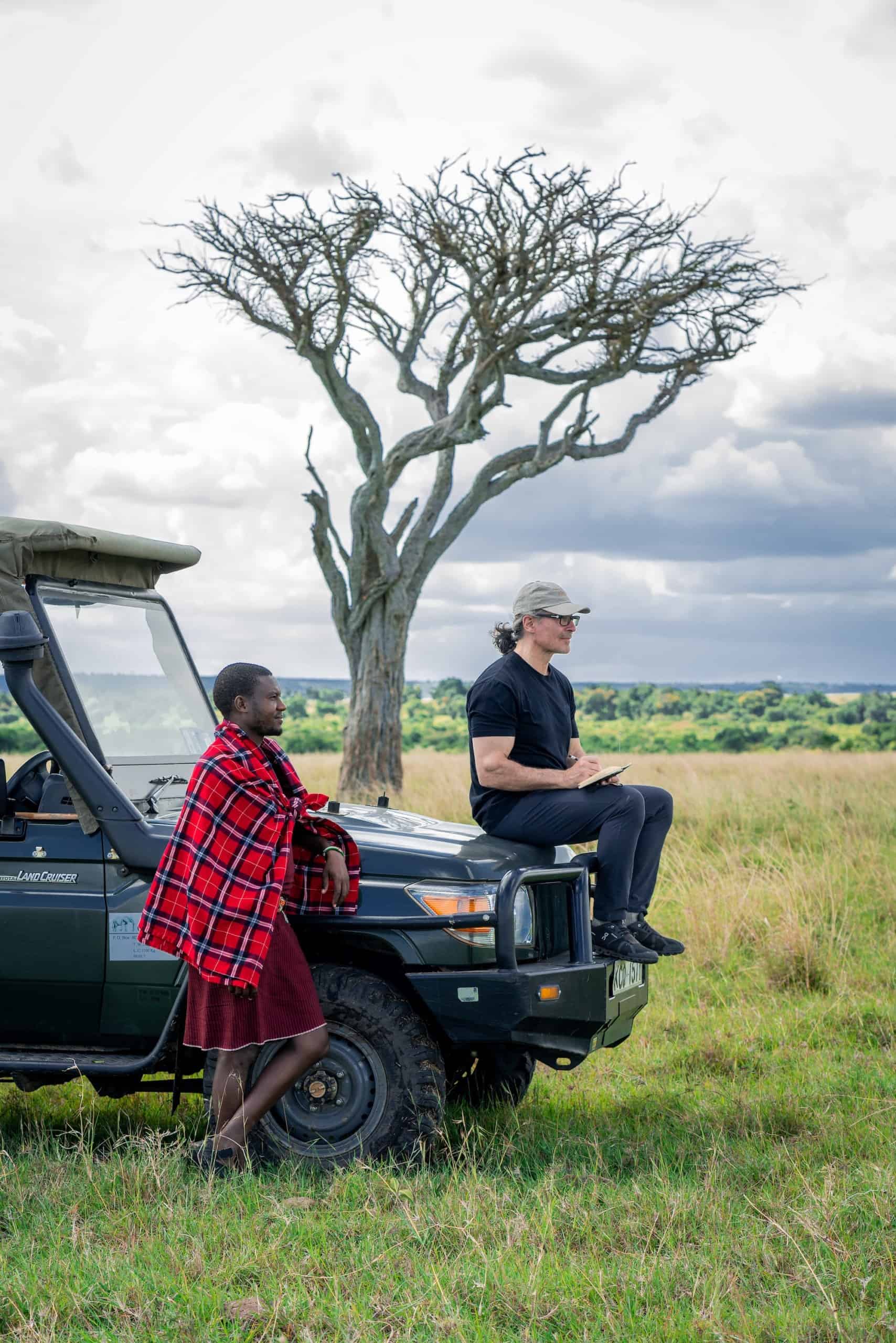
STORY BY Tyler Sharp
PRESENTED BY Safari Club International
John Banovich is not your typical wildlife artist. With a mixture of past lives as varied as the oil paints on his palette, John has paved a unique path that has led him to the top tier of the art world, and to the forefront of global conservation initiatives. Born out of a lifetime spent in wild places — both as a hunter and a nature observer — his oil paintings depict raw and timeless beauty from the natural world in detail and a scale that is unmatched.
These works of art, sought after by collectors globally, have allowed John to spend a career in close observation of “big things with big teeth,” as well as raise awareness and funds to support over a dozen crucial conservations projects on three continents. He has been a friend and mentor of mine for nearly 15 years, and it’s a proud, full-circle moment to feature his work in Modern Huntsman, as well as have him paint an original for us, which you see on the cover. After a recent visit to John’s Seattle studio, I had the privilege of joining him in Kenya and Tanzania to document his process in the field, and discuss his views on conservation challenges that lay ahead — among other things. What follows in an excerpt of that conversation, and the rest will follow soon in the short documentary we produced in partnership with Safari Club International. For now, may his words and work inspire you to see some of these wild places for yourself while you still can.
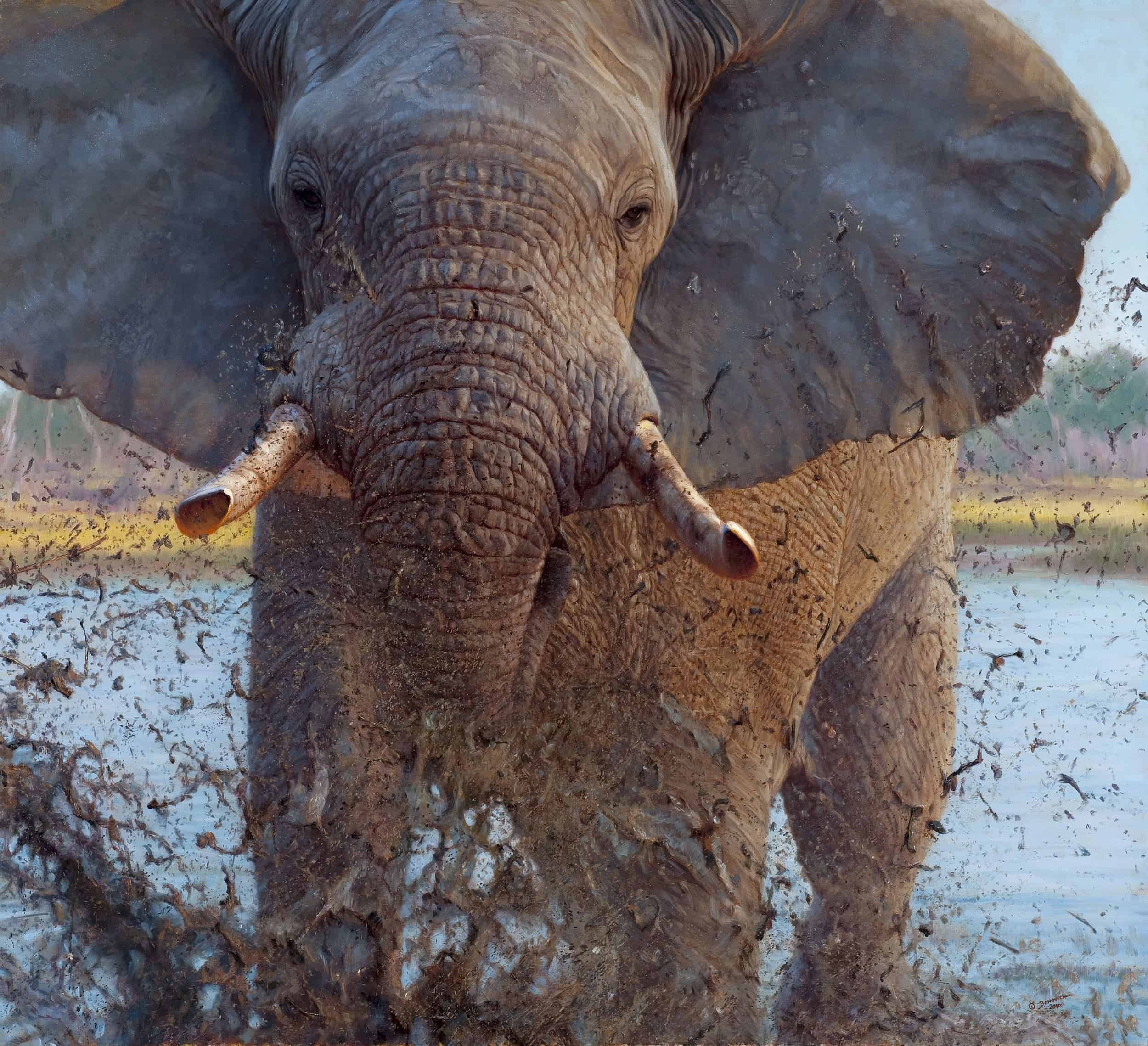
TYLER SHARP — To start off with, tell us a little bit about your background of fine arts and the path that led you to be a full-time artist.
JOHN BANOVICH — At age seven, I found my muse: Rudyard Kipling’s Jungle Book characters. That’s where it all began. I started to paint them, and I think the fascination with big things with big teeth, the power, strength and all those things that they represented, was born out of that. Wildlife was the subject matter that I ended up pursuing my entire life, and oil painting is the medium that I still work in today. And so, my career started out with the love for animals, and nearly 50 years later, I still find myself loving and painting that subject matter.
First of all, I didn’t want to be what I guess you would call a starving artist, so I pursued other careers. I tried to escape the art thing many times in my late teens and early 20s by becoming a personal trainer, which was part of an extension of my athletic and bodybuilding career. It was a nice evolution, but I always found myself going back to painting on weekends or when I had extra time. Then I thought, “I always wanted to be a real estate developer. That’s got to be a great idea.” I bought some houses, fixed them up, sold them, made some money, sometimes lost money. Again, always painting on the weekends or painting when I had that free time. And then I realized there was a certain point that I had to really get serious about art if it was going to be something that I was going to pursue. So I entered my works into the Pacific Rim Wildlife Art Show, which was the largest wildlife art show on the West Coast at the time, held in Tacoma, Washington. I entered a small painting; it was 8-by-10 inches, called “In The Heat of the Day,” of two African lions. I purchased a booth and exhibit space, which was in the far right corner of the entire exhibit hall, which is a big, big stadium arena. So, you had to look to find me.
During the competition, third place, second, and first were announced in sculpture, and then the same in painting. And I was like, “Hey, I did my best and gave it a shot.” And then they announced Best of Show. My painting won Best of Show. Mind-blowing moment. So surreal. I’ll never forget standing there in the corner, as an unknown artist, and winning Best of Show at the largest wildlife competition. I’ll never forget that on the day after the award ceremony, I arrived early, because I was pretty excited, and there was an older man, little round shoulders, standing near my booth, looking at my paintings. I said, “Good morning, sir.” I thought he worked for the show or something, because he was there so early. And he said, “I see you won Best of Show.” And I said, “Yeah, I did. I didn’t expect it, but I am pretty excited about it.” And he said, “How much is that painting on the wall?” I responded, “I don’t know, it’s like $1,400 or something like that.”
Anyway, he disappeared. And I thought, obviously he doesn’t want to buy it. So the show opens, two hours pass, he comes back and points to the painting. “It’s $1,490. You know, I’ve walked this entire show and yours is the best work in here.” And I said, “Thank you very much.” Also, I had a large scale painting displayed that was $4,800, which seemed like a huge amount of money at the time. I’d told myself, “If I can sell that painting, I’m going to Africa.” Well the gentleman stood there and said, “I’ll take them both.” “Thank you very much!” I said. “Wow. I’m super excited.” Anyway, he disappears, and the show director comes over. “Do you know who that was?” he asked. I had no clue. “That was Jean Worrell,” he said. “He’s got the largest wildlife collection in the United States in private hands. He just flew in on his jet from London.” I’d never met a collector like that before. Jean and I became friends over the years, and then with his widow after he passed away. They were always a real pillar in my career. I learned at that moment that there’ll be key people that impact your life, sometimes monetarily, sometimes in direction, sometimes just through support or introductions. You want to acknowledge, embrace and be receptive to those people that feed the soul of an artist. That understanding has served me well.

After that, there was a lot of interest from publishers and my work began appearing on the cover of the leading wildlife art magazines. My career literally felt like a rocket ship taking off. I left my personal training career, sold that business, and sold a rental house for a sum that allowed me to take the path that I was truly born to follow. Not long after that, I was on a plane to Africa for the first time. I jumped in with four feet, and I never looked back from that moment.
Back in those days, Maun in Botswana didn’t have paved roads yet, it was all dirt roads. So when I stepped onto the sands of the Kalahari for the first time, and felt my feet squishing into the hot sand, I felt like I was finally home. It just all made sense. Everything that had ever led up to that moment became clear. I thought, Okay, this is where I’m meant to be. It was a pretty profound moment.
Soon after, I realized I wanted to be my own director. I didn’t want to pursue the traditional gallery/artist model. I love to connect with people, and that connection drives everything. It directed the decisions on how I wanted to shape my career. At the time, there were some big shows like the Southeastern Wildlife Exposition, the Pacific Rim Wildlife Art Show, and several others that were a little bit second tier to those. You could build your own career dealing directly with collectors. There was no internet, there was no way to digitally do it, so that’s how you did it: face to face. And that’s how I met some great collectors.
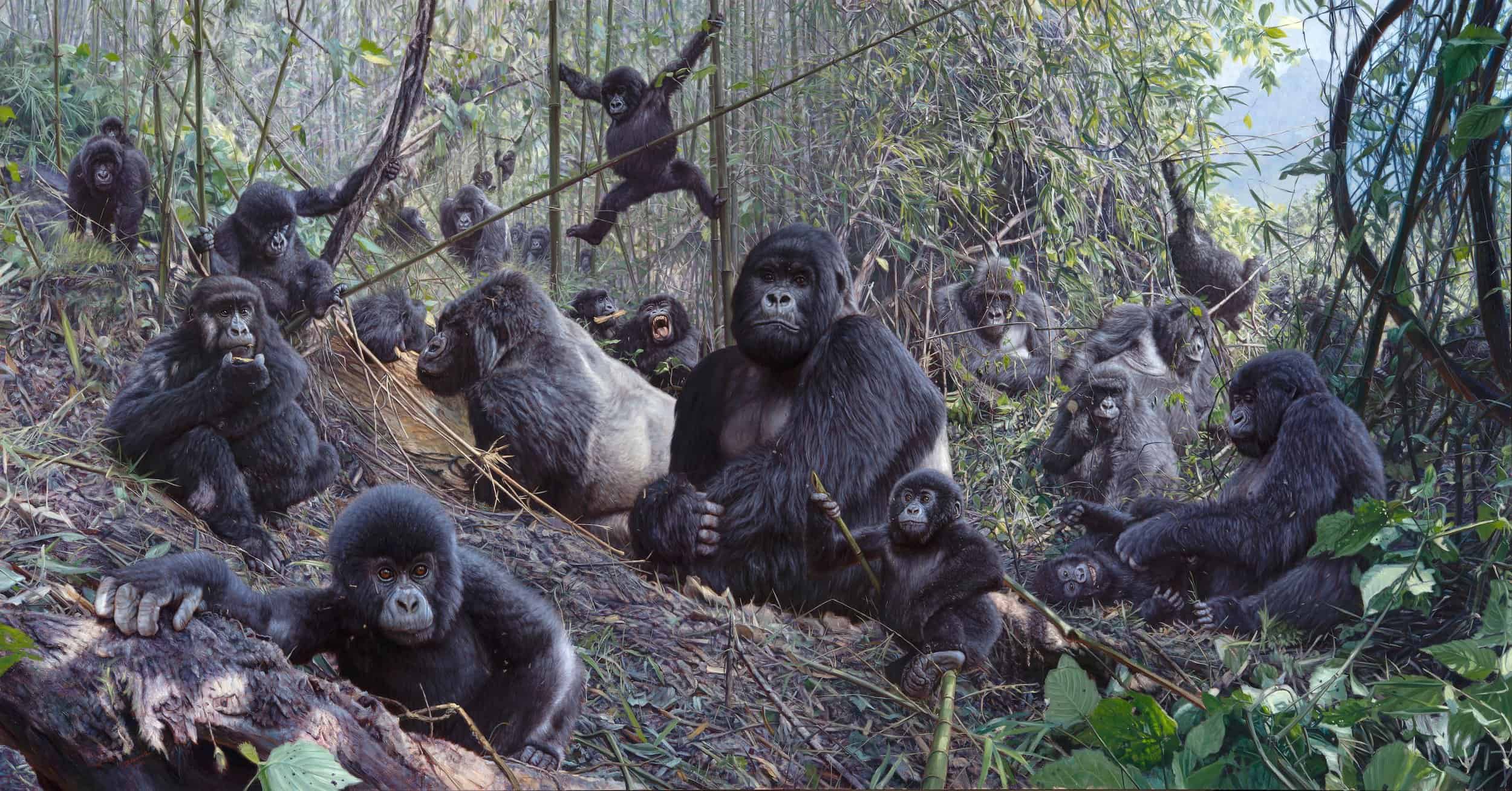
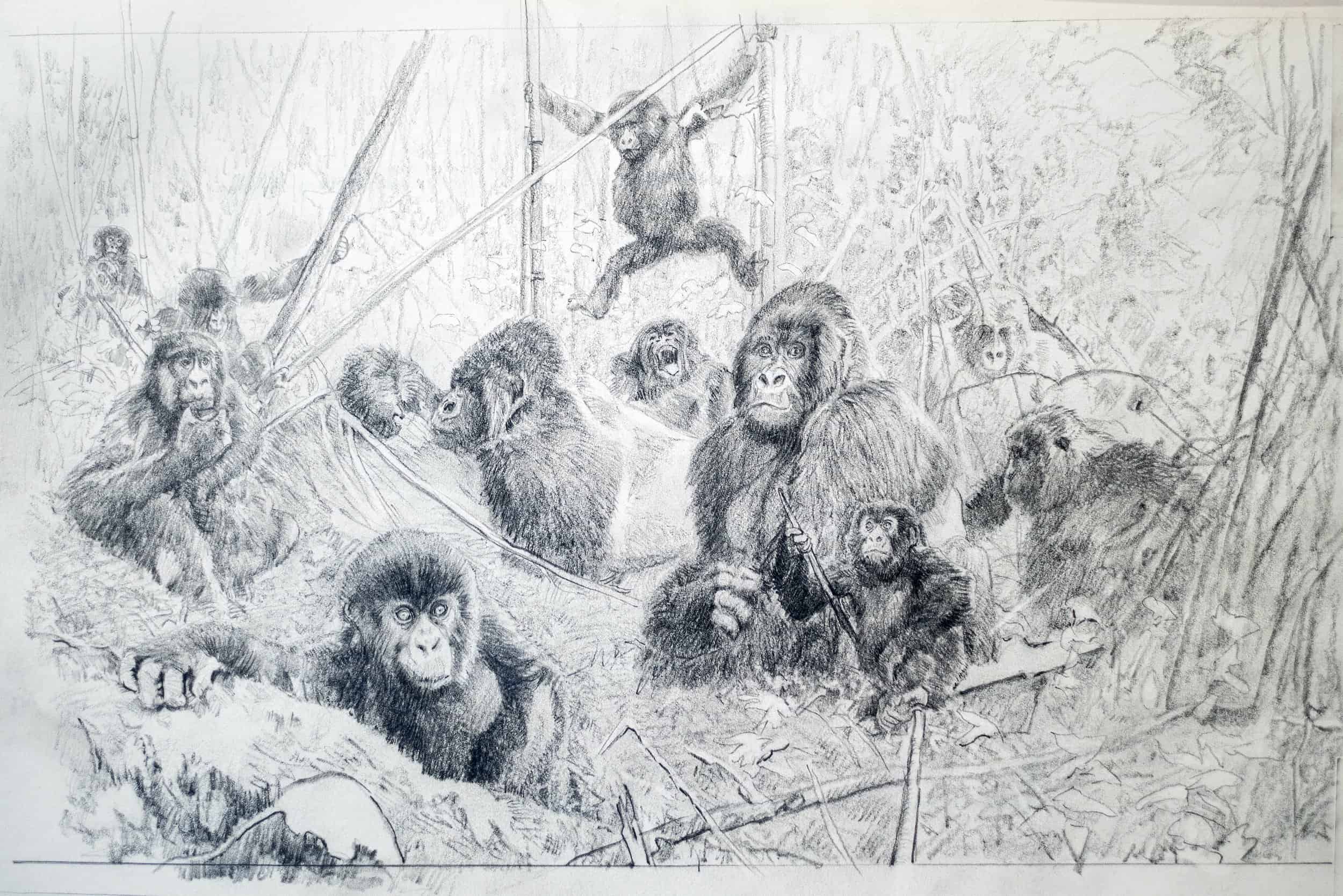
SHARP — Changing gears, I want to talk about your process. How do you go about picking your subject matter, and what is the process from there? Is it important for you to be in the field to find inspiration?
BANOVICH —I always look at things, and simplify. I see things in simple shapes first and light second and then subject third. I love the strength and the power that’s represented between positive and negative shapes. I love strength: strength of stroke, strength of beast, strength of man, strength of buildings, architecture. That’s why I love big things with big teeth, herbivores and carnivores, and it’s why I keep coming back to Africa, which represents probably 60% of my annual canvases.
But sometimes I think like a filmmaker, and say, “Okay, I’m looking for a location, I need to find aggressive lines, I need to find Cape buffalo lowering their heads, or lifting their heads up. I want lots of dust.” You can never orchestrate it, because wildlife doesn’t care about your career — they couldn’t care less, in fact. I do have a mission, and I try to find the best scenario to give me the material I need, but you have to be patient. A painting like “The Defensive Line” took 13 trips to Africa to get everything that I needed for the unique faces and shapes: intimate, close-up photographic references. I needed all those details in the eyes because each Cape buffalo in the original is like a foot across, and the whole canvas is 90 inches across. So, fieldwork is important.
Then there are those happy-accident moments that happen in the field that you don’t expect. I mean, that’s Africa. You wake up in the morning, and you have no idea what the day’s going to give you, and you have to be open to those unexpected moments. I’ve spent thousands of hours just observing for that reason. I tell my students when I do workshops to put the camera down. The camera is super important, you’re going to build your library with those shots, but put it down and just watch and watch and watch, and sketch. Sketching is not about how good the sketch is, because often it’s not good. It’s just connecting your eye to translate what you see and feel in your hand and on paper. The process is more important than the result. Quiet, introspective, intuitive feeling, and observing, and let that language of that beast speak to you, through you, and manifest onto paper. That’s my process.
SHARP — How can art influence action in the conservation space? Do you have any specific examples of big wins?
BANOVICH — Historically, you think about art playing a role in changing people’s perspective. I think it’s art or photography today. Even prior to that, art played a role in opening our eyes. I always say a camera captures a moment in time and distills it down, where art captures a story in time, and how we felt about it. Photography can simulate it, but art captures how we felt about what was in front of us, the emotion beyond it. Think about when Congress authorized an exploratory party to head West and they discovered Yellowstone Park. They had an artist with them by the name of Thomas Moran who recorded the whole expedition. Moran did field sketches, and ended up doing a few finished paintings. Yes, they gathered all the data, all the facts, and the surveys, but when they lobbied Congress to create the world’s first national park, the success was because of Thomas Moran’s paintings. It wasn’t because of the data, but all the emotional connection that was fostered through those paintings. That to me is probably the best story I’ve heard of where art played a role in significantly changing conservation as we know it. The world’s first national park was established because of those paintings. That inspired me a lot about why I create what I create.
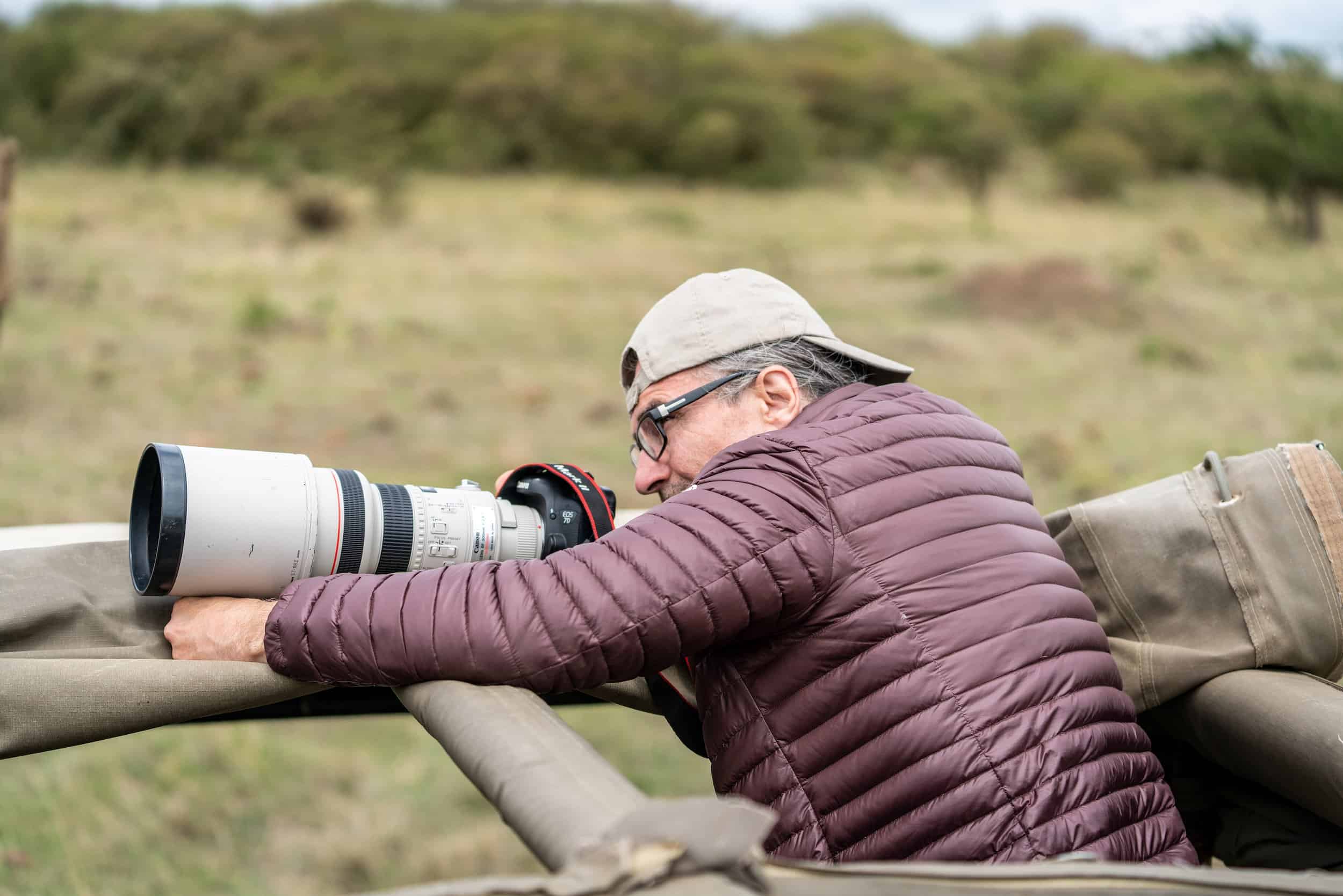
SHARP — You’re more than just an artist. Tell us a little bit more about the mission for your philanthropy and conservation work.
BANOVICH — I think every artist that is a realist, especially in the wildlife space or the nature space, wants to feel that their work is doing something good, something positive. So I often use my work for fundraising events and public awareness, and auction off both originals and prints. I did that for a couple of decades, but I never really knew how the money was being spent, and that always bothered me. As my career developed, I began to have more influence, and I learned a lot about conservation and how it works at the local, regional, national and international level, and how often NGOs get consumed by the survivability of the NGO and not about the mission that they sprouted from.
I wanted to be a better steward of those fundraising dollars, so we started Wildscapes Foundation in 2006. Having 501c3 status has allowed me to be a steward from the origination of the dollar to the ground level, and usher it all effectively. We work in tandem with lots of people, and it’s more about focusing the dollars and injecting them to where we get a tenfold return.

I won’t mention any names, but I’ve worked with quite a few NGOs and watched how badly they mismanage money. It’s not that they set out to mismanage it, it’s just the beast gets so big that you have all these layers. How can you create efficiency that can scale? That’s difficult to do. The good news is that we’re super small, but we have one of the biggest impacts because of how we can play, fill roles and connect people to bigger stories. Whether it be private or public foundations, or taking on something that nobody wants to because it’s a little controversial, I have the freedom to call it like it is, because I don’t make my living off of philanthropy. I can sit at a table and know that the result of the position that I take won’t have an impact on my income. Everybody else is usually at the table based on their position, and it impacts your income positively or negatively. At the end of the day, conservation today is about protecting the landscape. You have all these organizations built around saving species, but a species doesn’t need to be saved — it just needs to have a protected place to live, with food, water and security, and it’ll save itself. Animals are phenomenal at it. That, to me, is where we have the biggest opportunity for impact right at this juncture, because we still have these big, vast, open systems that are unfenced. They still exist. They’re disappearing very quickly, but they still exist. So the opportunity is, how do you prevent those from collapsing? I’m worried that we won’t even get 50 years out of many of them. I think now will be the deciding decades that put long-term management strategies or policies into place that allow a landscape to stay in what you call an open system, where it’s unencumbered. Wildlife can move freely in and out of it, utilizing both public and private land. It has value on both sides, and so that’s what the conversation should all be centered around. We’re at a triage moment where we don’t have that luxury of taking positions that represent our own self-interest or our own perspectives. We have to embrace other perspectives on how to save species and the landscapes that they live on.
SHARP — You have friends and clients on both sides of the aisle, hunting and non-hunting. Where do you stand philosophically, and how do you navigate those different circles successfully?
BANOVICH — Growing up a hunter in Montana, I was acutely aware of who was going out into that wilderness and who cared about that wildlife. I would see hunters out there every single day during hunting season, and even during the summertime months when they’d be out scouting. They were engaged and were really connected to the wildlife and wild places. Way more so than hikers. Hikers go out once in a while, but they’re not out there every single day. Even birders or photographers weren’t out there anywhere near as much, and that was something that always stuck with me. I started out as a hunter with my father as a young boy. Then I became an animal lover and didn’t want to kill anything. My dad would shoot ducks, and if one didn’t die, I’d bring it home and try to nurture it back to health. It would live with us for three months, then we’d release it. So there were always animals at our house, and I sort of became an anti-hunter. I just didn’t like it at all. I didn’t like killing wildlife, and it took me a while to come back around. In high school, I started having an interest in archery again and got back into hunting, but realized that it wasn’t about killing. Today I still have a problem with extinguishing a life. But all of the pageantry and all of the methodology, getting to the point where you have the opportunity to make a successful shot, whether it be a rifle or archery, I just love that whole psychological process.
And that process of hunting was laying a foundation for my artistic process. When I went to pursue my subjects with a pencil or a sketchpad, it was the same. I didn’t wear one hat or the other, it was one hat. So I evolved with the mindset of a hunter, but most of my time in the field became capturing stories for my paintings, but I was hunting for encounters. I drifted away from archery for a while, but have gotten back into it in the last five or six years. I think I love it more now than I ever have. It’s so complex and difficult. Everything around matters; the birds matter, the ground matters, the wind matters. It all has to line up perfectly to work out. So many times when you finally get the chance to make a shot, there’s a stick, a bush or grass in the way — something that will impede the perfect shot. I don’t really rifle hunt anymore. Matter of fact, the moment I shot my first Cape buffalo with a bow, every gun I owned was for sale.
SHARP —With this journey you’ve been on, seeing and understanding both sides, how do you take your experience to try to broker constructive conversation between them?
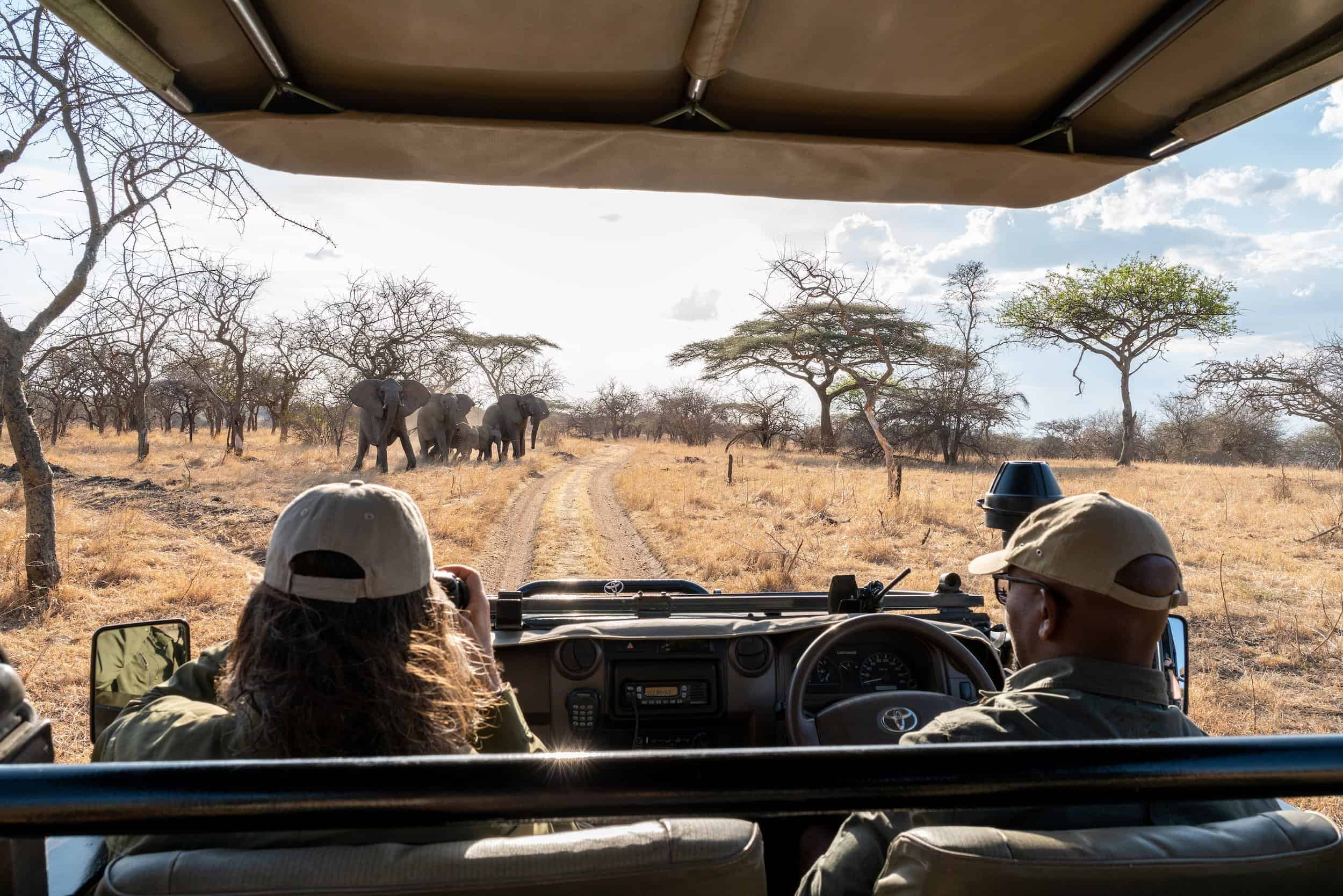
BANOVICH —Well, first of all, you have to establish comradery, and empathy for both sides. On the anti side — because I’ve gone through that as a person and my art brings me to those tables often — it’s that they don’t like the aspect of somebody killing something. It’s not so much about death, because animals kill animals in order for species to survive. It’s more of a disdain for what they often think as an arrogant and aggressive attitude that someone wants to extinguish a life to stick a head on the wall. I get that perspective. Matter of fact, I think most people get that perspective, but that’s the wrong narrative for hunting. First, there is not a human being out there — and I will argue this to the end of my days —that loves wildlife more than me. There isn’t. I’ve dedicated 40-some years, over a thousand paintings, and millions of hours of painting telling their stories. And if wildlife was being exterminated through the act of hunting, I would be the most vocal and aggressive person on the scene. I would be right at the tip of that spear. So that establishes comradery because they see in my work that I’ve paid homage to these species. I’m not painting sporting scenes. I’m painting a timeless story that could have taken place yesterday or 500 years ago. From there, I think art can play that nonpartisan role. So how do we protect the habitat that they rely on to live? You need money to do that. At the end of the day, we are something like 10X short of an annual injection of capital to the world’s remaining wildlife habitat. I’m being very general with my numbers, but as a general statement, we have to raise more capital in order to protect these areas where the use of that land can be competitive. So we’re often losing wild spaces because there is no incentive.
Therein lies the opportunity for hunting, because it is incredibly effective economically for conserving wildlife on the landscape or conserving the habitat that wildlife needs to exist and coexisting with communities that live around and engage in those natural resources as well. There is a balance, because sometimes photography or ecotourism doesn’t necessarily work with communities, and hunting often creates jobs for local communities in the form of trackers, scouts and skinners, etc.
Hunting is also not a massive infrastructure investment, so the minute that there’s an economic collapse in a country or region in the world, or globally, like we just had with COVID, it can sustain itself much more. It’s also low impact. You move very few people through that landscape, so wildlife gets to live largely unencumbered by the presence of human beings. If you don’t believe that, go to a waterhole and sit there for 10 days from sunrise to sunset, and watch how every human that comes by impacts the wildlife that’s around it, or how a vehicle moving through a landscape makes elephants change their posture and behavior.
It’s very interesting how many perceive ecotourism as a better land use choice than hunting. In certain landscapes, it can be a better management tool, but only if it’s beautiful and accessible enough, and has enough wildlife in it to be an ecotourism place that meets all of those metrics.
However, roughly 70% of remaining wild habitat in Sub-Saharan Africa lies outside of those pristine, beautiful, easily accessible places. That is where hunting is a great choice. The effectiveness of a really well-managed hunting program is extraordinary, and most ecotourists or people in the industry have no connection or understanding of the concept that you harvest a few to save many.
Anti hunters often pursue this idea of stopping hunting with the intent of stopping the killing, which I get; you want to save something, stop killing it. But when you look deeper into it, it’s not about killing. It’s about the habitat and who’s paying for that habitat. That’s where I think the whole debate should shift away from pro or anti hunting, or should we kill or not kill? That’s a personal choice. What we need to embrace is this collective understanding that wildlife habitat has to be paid for, and we need to be sensible about the best option in specific areas, and how sustainable those options are. These are the types of conversations that I try to foster.
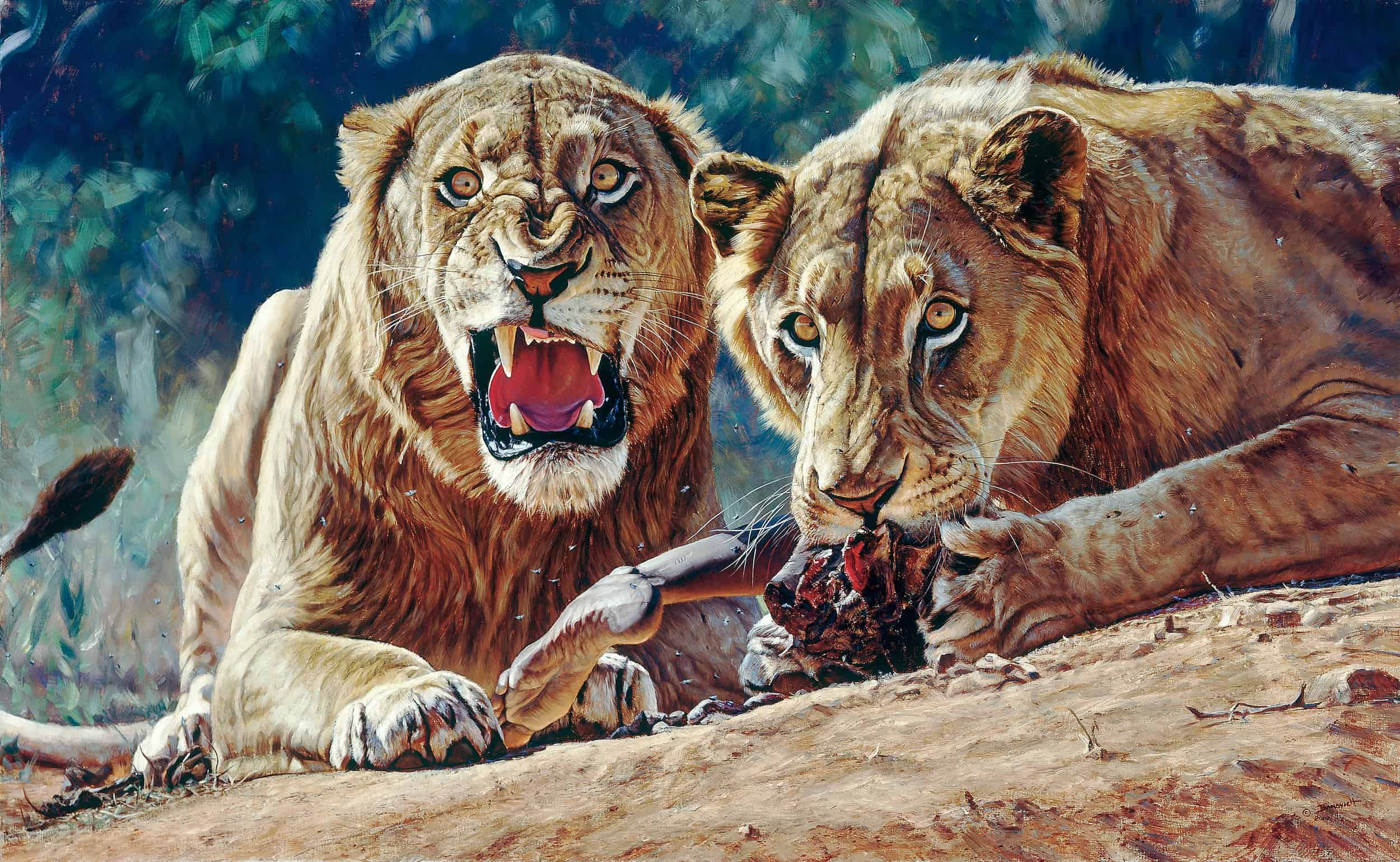
SHARP —How do you feel about the impact that outside international opinion has on African affairs? Let’s call it what people in the West think about Africa, then imposing their views in local communities.
BANOVICH —I’m sure you’ve heard that statement, but we can’t have Western solutions for African problems. They’re totally different. We have to remember that our perspective, our daily challenges are so different from what many African people have to deal with. I think that to be successful, we have to put ourselves in their shoes. It’s not easy to do, especially if you’ve never been there before. There’s very few media outlets that do a good job of relaying that.
Modern Huntsman is an exception to that, and I think your team excels at portraying a balanced reality of what’s taking place on the ground in many places. It affords us the opportunity to see a fresh, unique and localized perspective, because how a local villager views wildlife on a daily basis is different from somebody who lives in a city or a township, versus somebody who lives in a very dense urban center or is in high-level government politics. You have to involve local perspectives and voices to find the right solutions, instead of allowing social media/armchair activists who claim to love wildlife that they have very often never actually seen in the wild.
SHARP —Is there a conservation story happening right now that you’re particularly passionate about?
BANOVICH —Yes. There’s lots of them. I think as a conservationist it’s so easy to get sucked
down into the drain of failure, because there are plenty of collapses and there’s enough depressing information coming out of wild regions. Take an area that we’re going to, the Grumeti Reserve in Northern Tanzania. I know that one well because I went there when it was first transferred to the new owner. It was a mismanaged area before, and the wildlife was getting hammered with poaching. They were losing roughly a quarter million wildebeest during the migration. I mean, that’s not sustainable. The new owner injected the necessary capital and made infrastructure investments in the community to get their support. They created a new way forward, a new paradigm. You have to understand how valuable the community perspective is. Conservation is not sustainable if local communities are not financially benefiting. If their daily life is not measurably better for tolerating living with wildlife, then it’s a failed effort. That’s the crux of conservation. And that’s not only true in Africa, it’s true across every landscape we exist in. This model worked really well. Three years later, there were herds of eland and oribi. I didn’t know oribi hung out in herds. Today there are roughly two million wildebeest. Matter of fact, when the wildebeest get to this area, they don’t even want to migrate to Kenya. It takes a lot for them to be incentivized now to go across the border. The grass ecology has changed due to the way they strategically burned, and how often they burned. It went back to more historical and nutritious, less fire-resistant grass.
In terms of measuring success, I would say cats are kind of the indicator, because if their numbers are stable, everything else is fine. You don’t even need to look at anything else. If big cat numbers are declining, you’ve got a problem — there’s a reason why, that needs to be understood. But their numbers are increasing, you know you’re getting everything right. African cats are the canary in the conservation coal mine.
The Grumeti Reserve isn’t big compared to other areas, only 345,000 acres, but it’s one of the most successful examples of a conservation strategy that is yielding on all fronts. It’s scalable, but it takes capital and resolve, and it takes a high level of patience to deal with all the government idiosyncrasies and challenges. Oftentimes, when a new administration comes in, they can change policy and change their perspective on it, but you have to be willing to tolerate that risk.
SHARP —What legacy do you hope to leave with your work?
BANOVICH —It’s hard to distill it down, but I just want to be known as a person who loved wildlife, who embraced his moment in time on the earth and caused people to think and to connect and inspired them to take action. I know that we can’t save everything. We’re not going to save the whole patient. We’re going to lose an arm. We’re going to lose a leg. We’re going to lose an ear. We’re going to lose some important parts of these conservation landscapes as we move into 10, 11 billion people in the early part of the next century. But if we can save what’s important — the heart and lungs, the biomes that really matter, what I call the incubators of these areas. They don’t have to be big. Sometimes they’re small and they incorporate two bigger areas. But if we can save those really important pulmonary systems, we can have wildlife still roaming in an unencumbered way, for my children and grandchildren. That’s what I want. I mean, selfishly, I want my children and grandchildren to go experience some of the great things that I was able to experience. I want that for others as well. Not just my family. It’s daunting, it’s challenging. But I think that if my work can cause just a handful of people to take action and to be inspired by it, I consider that a success.
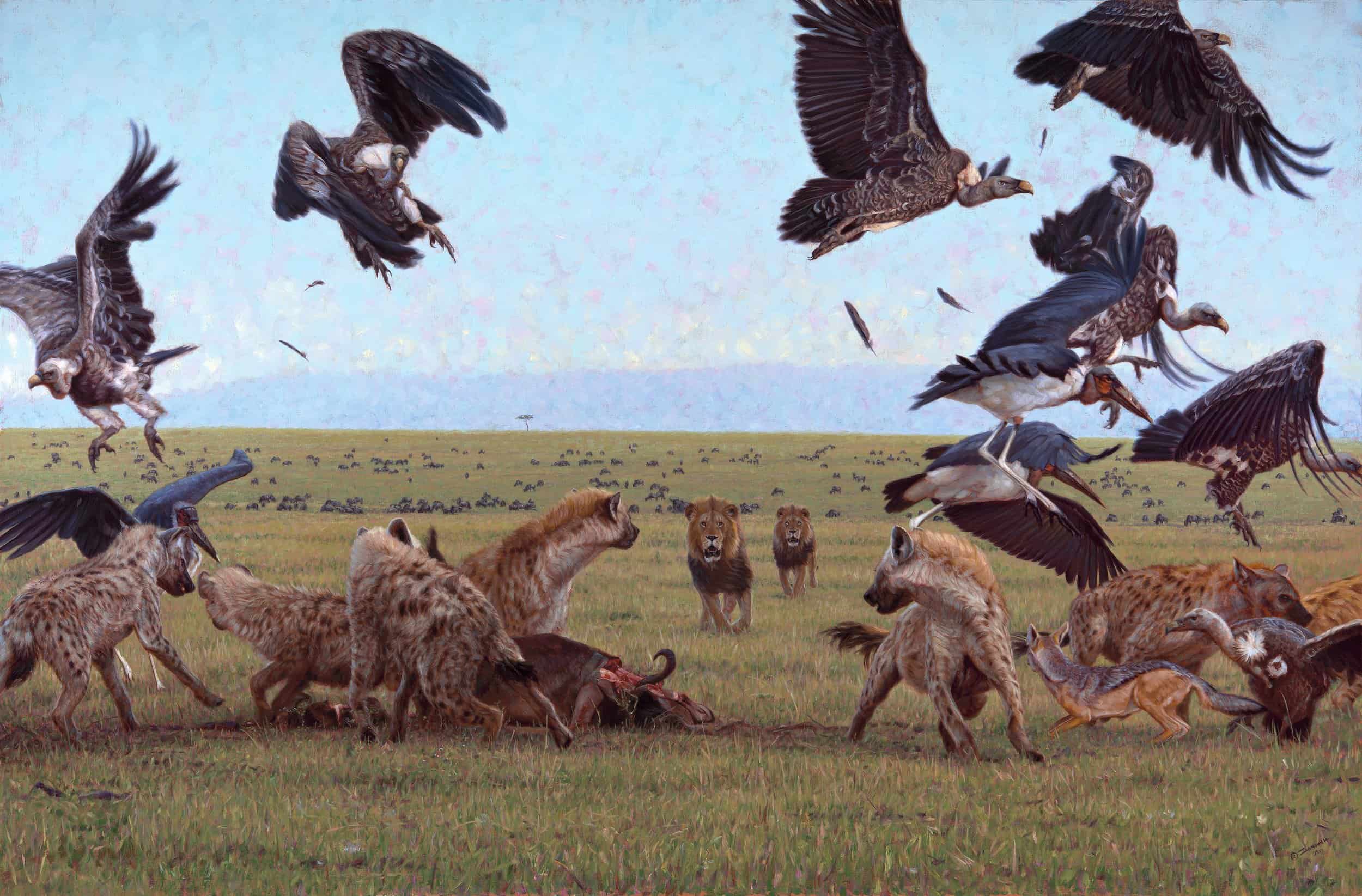
Originally published in Modern Huntsman Volume 8
Related Stories


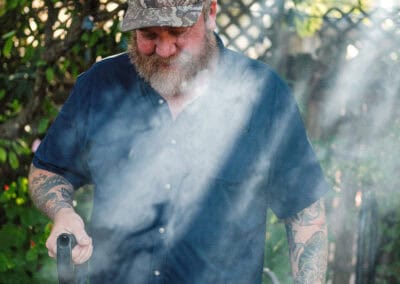
Latest Stories


